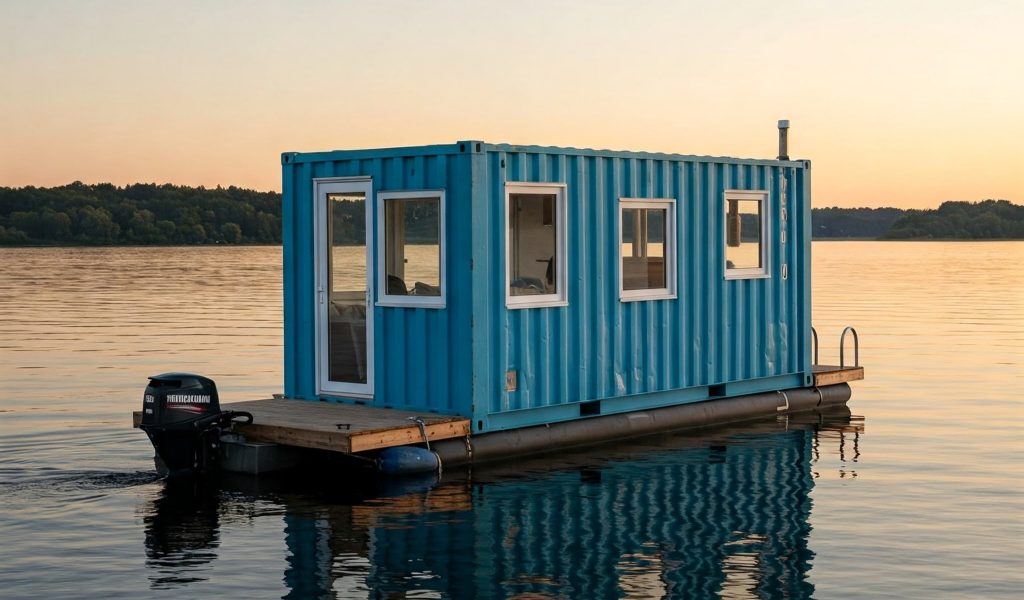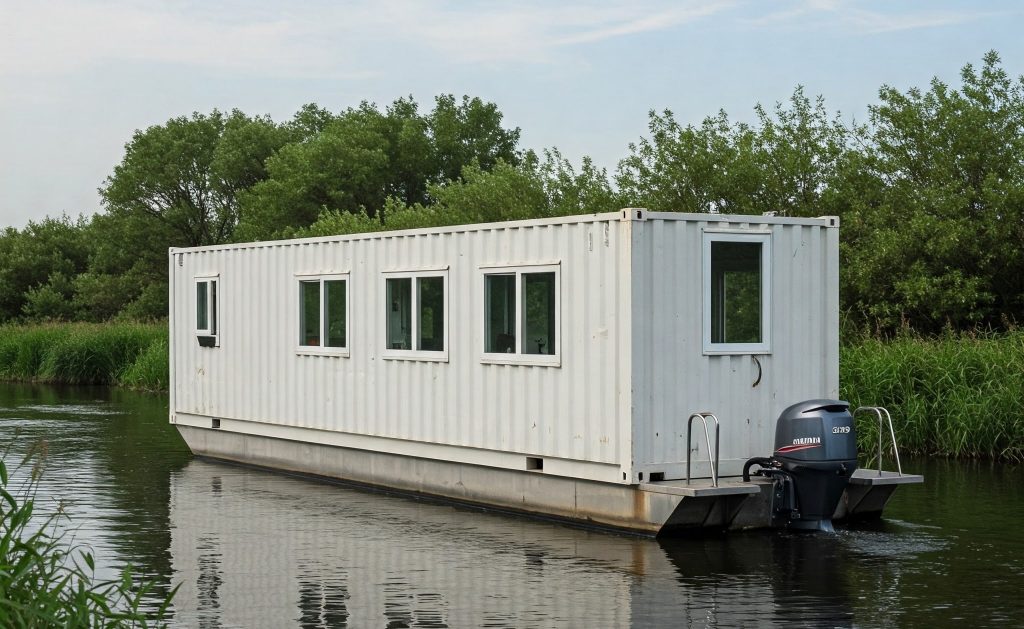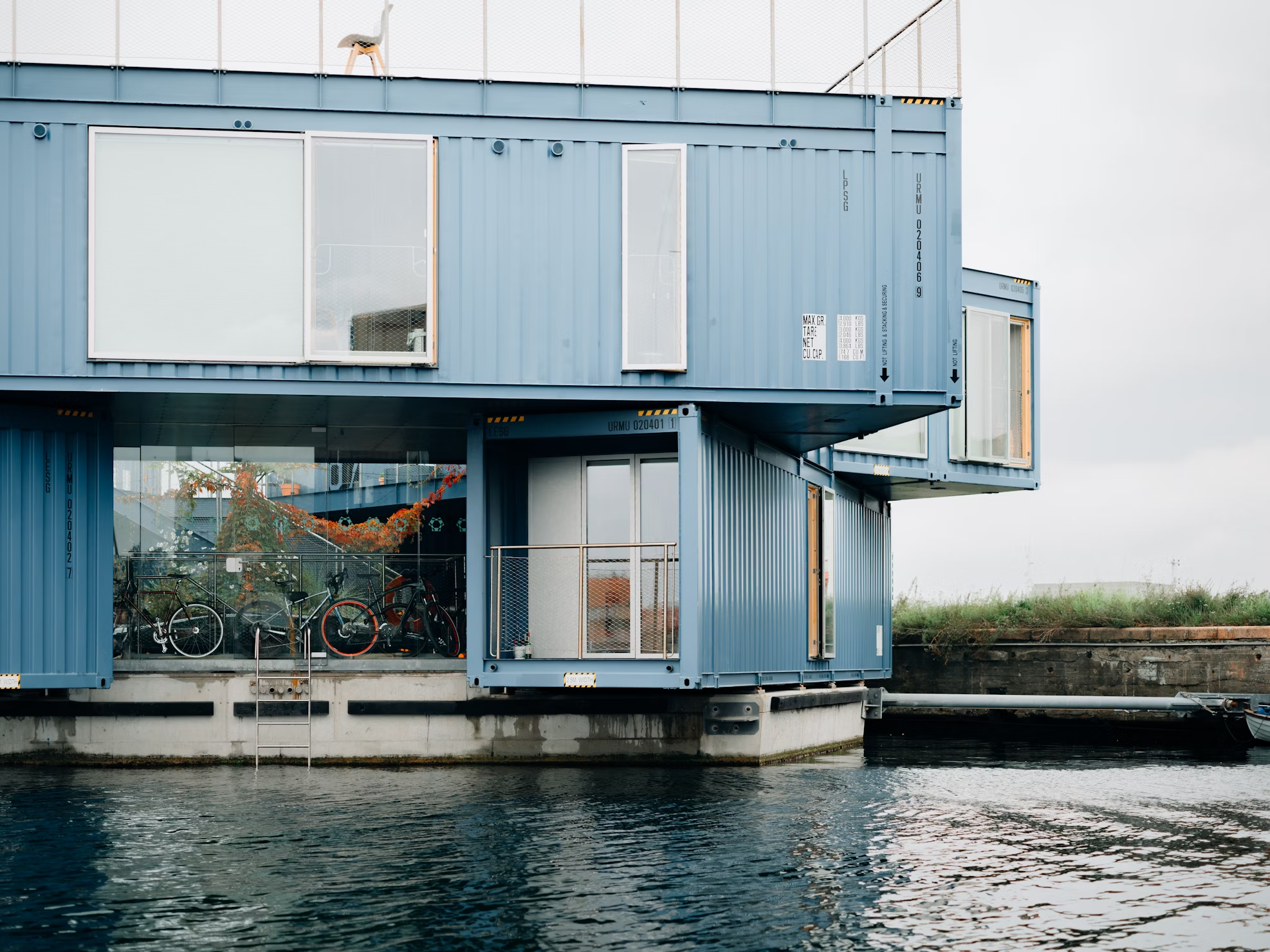Among many container home types, a shipping container houseboat is one of the most appealing and prominent.
Widely customizable and with many benefits, a container houseboat can give you a living experience unavailable in other container homes.
However, this is true for conventional home types as well. Having a houseboat can give you an unparalleled view of your natural surroundings.
Even so, what are the edges a shipping container houseboat has over other homes? Read more below!
Also Read: Lighting and Electrical Fitouts for Shipping Container Home Interior
The Appeal of Having a Houseboat in Your Life

To begin with, what makes a houseboat appealing to some people?
For these enthusiasts, having a houseboat means embracing a lifestyle that combines adventure, serenity, and freedom.
Imagine waking up to the gentle sound of waves of Lake Tahoe lapping against your home or enjoying breathtaking sunsets from your deck.
Houseboats allow you to live in places with natural views while offering mobility and flexibility that traditional homes cannot match.
For many people, houseboats provide an escape from the hustle and bustle of city life, allowing them to disconnect from noise and distractions while reconnecting with the natural world.
Houseboats also cater to those who value freedom and flexibility. If you don’t want to install your container houseboat in a fixed position, install it on top of an engine-powered barge instead.
Moreover, houseboats can be an excellent recreational investment. Anytime you want to go fishing, swimming, and water sports, all you need is to go outside your home!
The Downsides of Building a Conventional Houseboat

Unfortunately, even conventional houseboats have some disadvantages that can discourage people from having one.
Construction Challenges
Firstly, because houseboats are built in aquatic environments, you need even more specialized construction materials to stabilize them in these places.
To give you an image, the average cost of buying a narrowboat or Dutch barge can exceed $50,000, and that’s before factoring in maintenance expenses.
Maintenance
Maintenance is another significant drawback. Conventional houseboats require frequent upkeep to prevent issues like rusting hulls, leaking roofs, or malfunctioning engines.
Whether your houseboat is engine-powered or constructed in a fixed position, you must regularly check your engine or home foundation for any water-caused problems.
Additionally, managing waste disposal systems and water tanks also makes maintaining a houseboat challenging.
Limited Space
Space limitations are another concern for conventional designs. Due to their compact size, owners often must downsize their belongings just to live in houseboats.
This is true especially if your houseboat is a mobile one on top of a Dutch barge or narrowboat that only have very limited space.
If you know how narrow they are, then you know that you can only put so many things inside them.
Regulation Requirements
Lastly, regulatory requirements can be stressful for any homeowner, especially if their homes have unconventional designs.
Unfortunately, local governments often debate the feasibility and legality of constructing houseboats, which only complicates things.
Even in places that allow houseboats, you still need to comprehensively read through all the regulations to ensure your houseboat is free of any legal problems.
How Shipping Containers Are Convertible into Houseboats

As it turns out, the conversion potential of shipping containers is also possible if you want to turn them into houseboats – stationary or movable ones!
Although its construction process differs from regular container homes in some aspects, it nonetheless isn’t that different in others.
The Conversion Process
If you want to turn one or several shipping containers into a shipping container houseboat, here’s what you need to do:
- Hull Preparation: Mount your containers onto pontoons or flat-bottomed barges to provide buoyancy and stability on the water.
- Structural Modifications: Add windows, doors, and ventilation systems to transform the container into a livable space.
- Interior Design: Install some insulation layers along with flooring, walls, and ceilings to create comfortable interiors.
- Utility Systems: Integrate some plumbing for water supply and waste management along with electrical wiring for lighting and appliances.
- Exterior Coating: Use marine-grade paint to protect against rust and enhance aesthetics.
Benefits of a Shipping Container Houseboat for Your Life

You can reap these benefits if you convert containers into houseboats instead of using regular materials to build them:
Affordability
One of the biggest advantages of using shipping containers is cost. Buying a used container can be relatively inexpensive – often just a few thousand dollars!
Even after outfitting it with insulation, windows, fixtures, and floatation, many container houseboats end up costing less than their traditional counterparts.
You’re also likely to save on materials and labor, especially considering the houseboat’s smaller size than most conventional homes.
And if you’re crafty with sourcing reclaimed materials or opting for minimalist finishes, you can save even more money.
Strength and Durability
If there’s one thing we can all agree on turning containers into homes, that’s their durability and survivability in nearly any place and condition.
The steel frame is solid and resistant to pests, mold, and rot, which are common problems with wooden boats.
With proper coating and occasional maintenance, you can be sure that the houseboat itself is free of any problems for decades.
Once you have done the above, regularly check the barge or pontoon’s condition to keep the houseboat stable as long as possible.
Customization
Shipping containers are essentially blank canvases. Their boxy shape may look rigid, but inside, you can do whatever you want with it.
Whether you want a studio-style layout or a multi-room setup with a loft, you can make it happen. Add large windows to let in natural light, or build out a deck for outdoor lounging.
Plus, the modular nature of containers means you can stack or connect multiple units to expand your space.
Want an office, a guest room, or a rooftop lounge? You can create it without starting from scratch!
Sustainability
Container houseboats can use solar panels, rainwater collection, and composting toilets, making them a smart choice for eco-conscious folks.
Living on a container boat encourages a minimalist lifestyle too. There’s limited space, so you’ll likely consume less, waste less, and focus more on what matters.
Portability
Though not as nimble as a sailboat, a shipping container houseboat can still be moved with the right equipment.
For instance, you can install an outboard motor engine on the houseboat’s rear to move the house as needed with your means.
Alternatively, you can ask for help for a ship to tow the container houseboat and anchor it in your desired location.
Space-Savvy Living
While containers do look small on the outside, clever design can turn them into highly efficient living spaces.
Use built-in furniture, under-bed storage, fold-away tables, and multi-functional layouts that can all fit inside your houseboat.
And because you’re designing from the ground up, you get to create a space that works perfectly for your needs.
Mistakes to Avoid When Constructing a Shipping Container Houseboat

When you convert containers into houseboats, you should avoid making these mistakes at all costs:
Ignoring Weight Distribution
Shipping containers are heavy, and uneven weight can affect buoyancy and stability. So, always plan your layout to balance the container evenly on its floatation system.
Using Improper Floatation Materials
Not all materials can safely support a container’s weight. Avoid solutions like underpowered plastic barrels and use marine-grade pontoons or engineered floatation systems.
Skipping Proper Insulation
Failing to insulate properly can make the houseboat uncomfortable, so apply moisture-resistant insulation suited for marine environments.
Poor Ventilation Planning
Without good airflow, condensation builds up quickly inside container homes, especially on water. Add windows, vents, and possibly dehumidifiers to maintain air quality.
Overloading the Structure
It’s tempting to build upward or pack in features, but too much houseboat weight can compromise floatation and safety. Know your limits and design accordingly.
Overlooking Marine Regulations
Building a houseboat means dealing with waterway rules, mooring laws, and safety codes. Failing to research local regulations can lead to fines or relocation.
Also Read: Shipping Container Deck: Perfect Addition for Container Homes
Conclusion
By understanding the appeal and benefits of a shipping container houseboat, you can have one of the most unique experiences of living in a container home. To ensure your container for the houseboat is of the highest quality, source it today only from Tradecorp! With an enduring commitment to build the containers to last decades, Tradecorp’s containers are convertible to nearly any architectural project you want.


